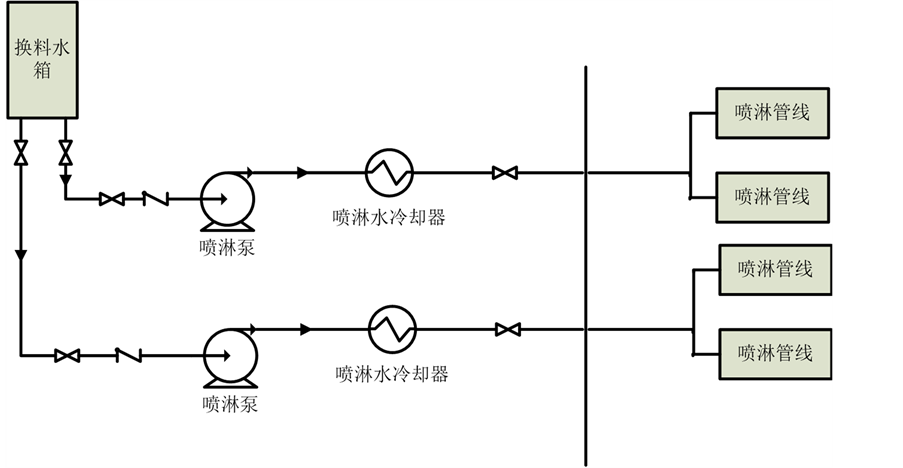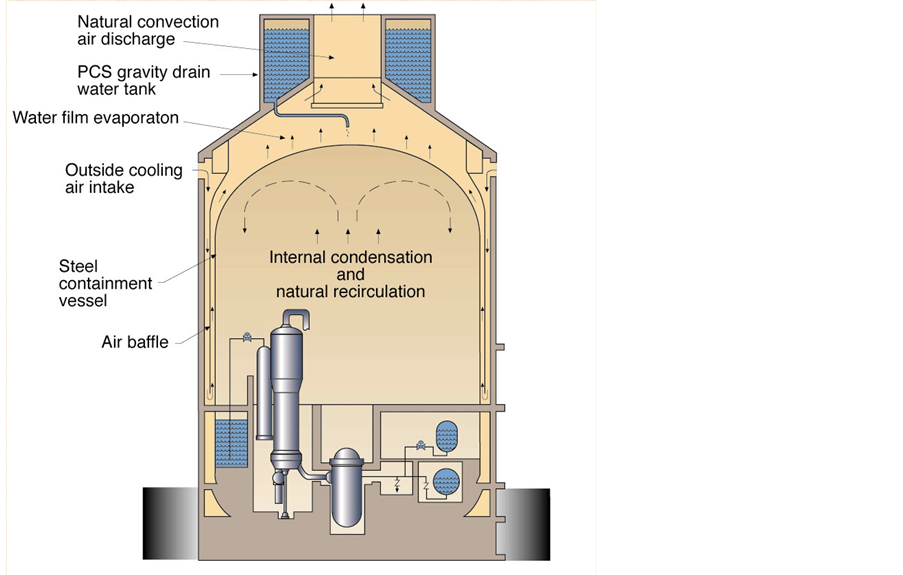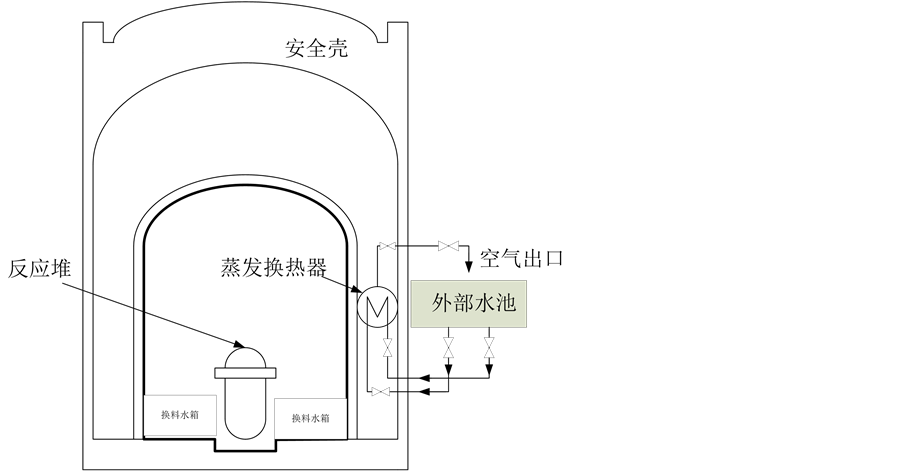1. 引言
2011年福岛事故后,国务院对中国今后该如何发展核电提出了两项要求:采用最先进的技术和最严格的标准,同时要求“十三五”及以后新建核电机组力争实现从设计上实际消除大量放射性物质释放的可能性。安全壳是核电厂为防止放射性裂变产物释放的最后一道安全屏障,用来限制事故工况下放射性物质从堆芯和反应堆冷却剂系统释放到周围环境,同时将运行工况下放射性物质的释放降至最低限度,并保护反应堆不受到外部事件的损害。安全壳主要由:安全壳构筑物及其延伸部分、安全壳隔离系统、能量控制设施(限制作用在安全壳内的压力、温度、机械载荷上)、放射性核素控制设施、可燃气体控制设施组成。安全壳冷却系统被设计用来限制安全壳内的压力和温度,同时兼具放射性核素去除功能。
在事故条件下,如何优化安全壳内热量导出设计方案、保证安全壳能够经受反应堆主冷却剂系统短期和长期的质能释放所带来的压力和温度等冲击、保证安全壳的完整性以防止放射性物质泄漏是核动力厂必须考虑的问题。
目前,第二代核电技术(如大亚湾核电站)反应堆专设安全设施采用能动设计理念,能动专设包括:安全注入系统(RIS)、安全壳喷淋系统(EAS)、辅助给水系统(ASG)和安全壳隔离系统(EIE)。在很多种假想事故情况下,这些系统主要用来确保反应堆紧急停闭、堆芯余热的排出和安全壳的完整性,以便限制事故的发展和减轻事故的后果。这些系统都由两个冗余系列组成,任何一个系列发生故障,都不会导致该系统安全功能的丧失。其中,安全壳喷淋系统执行安全壳冷却功能,同时兼具除碘功能。
第三代核电技术中,美国西屋公司的AP1000先进核电机组大量采用了非能动技术,依靠重力、自然循环等来保障反应堆的安全,即采用非能动安全系统来改善核电厂的安全,这些系统仅仅利用自然力因素,例如重力、自然循环和压缩空气来使系统工作,而不需要采用泵、风机、柴油机、冷却机或其他能动机器。AP1000安全壳冷却系统采用非能动设计,在事故发生的短期采用喷淋水膜和空气自然对流的方式导出安全壳内热量,后期依靠空气自然对流实现热量导出。
本文调研了核动力厂安全壳冷却系统设计方案,在进行方案比较的基础上,提出了先进核动力厂安全壳冷却系统设计发展思路,从而为新堆或小型堆的安全壳冷却系统方案提供设计思路参考。
2. 安全壳冷却系统设计方案调研分析
2.1. 能动安全壳冷却系统设计方案
当前运行中的第二代核电技术中,安全壳冷却采用能动设计理念,如大亚湾核电站的安全壳冷却功能主要由安全壳喷淋系统(EAS)来实现。在发生大破口(LOCA)或安全壳内二回路管道破裂的情况下,安全壳内压力和温度升高时,EAS将含有氢氧化钠的硼水均匀地喷入安全壳,使安全壳内压力和温度降低至可接受的水平,以保证安全壳的完整性。同时,注入的氢氧化钠可以提高水的pH值,使硼水的酸性所引起的安全壳内金属腐蚀减至最低限度,并且降低可能释放出来的放射性碘。大亚湾核电站安全壳喷淋系统设计原理图见图1所示 [1] 。
为保证喷淋的可靠性,每台机组的喷淋系统由两条相同的管线(系列A和系列B)组成,每个系列能保证100%的喷淋功能。
每条管线由下列设备组成:一台喷淋水泵(EAS001PO/002PO)、一个化学添加剂喷射器(EAS001EJ/002FJ)、一个热交换器(EAS001RF/002RF)、两条位于安全壳顶部不同标高的喷淋集管以及共同的化学剂回路。
两条管线共用的化学剂回路包括一个化学添加剂箱EAS001BA和一台搅混泵EAS003PO。
此外,还有两条管线共用的连接PTR001BA的喷淋泵试验管线。
EAS供水分两个阶段,第一阶段(直接喷淋)从换料水箱PTR01BA取水,第二阶段(再循环喷淋)从安全壳地坑取水。
2.2. AP1000非能动安全壳冷却系统设计方案
三代核电AP1000采用非能动安全壳冷却系统(PCS)设计方案,PCS 可在事故发生后对安全壳进行有效的冷却,从而保证安全壳不超压并迅速降压。非能动安全壳冷却系统的原理中第一个过程是安全壳内的蒸汽由安全壳的内壁面冷却,凝水流回安全壳底部,实现安全壳内反应堆的再循环冷却;第二个过程是安全壳的外壁面由安全壳冷却水箱的分配装置在安全壳穹顶和圆柱筒体形成均匀水膜,以及自然对流的空气冷却安全壳,反应堆余热最终经过安全壳屏蔽厂房的空气出口排入大气。如图2所示 [2] 。
钢制安全壳提供了热交换表面,将安全壳内部的热量发散到大气中。热量被循环不断的自然空气气流带走。在事故持续期间,安全壳内的空气冷却还可通过水的蒸发来得以强化,水从安全屏蔽厂房顶部的水箱流出。双层安全壳结构是系统赖以工作的根本,安全壳的内层为45毫米厚的钢质安全壳起密封及承压的作用。外层为钢筋混凝土结构用以抵抗外部侵害。在内/外层安全壳之间布置有一层空气导流板以帮助建立非能动空气自然循环。
在安全壳的顶部布置有水箱,共设三路喷淋阀,在仪电系统故障情况时处于安全有利开启位置。由于事故初期是安全壳内热量积聚最严重的阶段也即最需要对安全壳提供冷却,为此水箱内四组在不同标高布置的立管可非能动地自动调节冷却水的流量,随水箱水位的降低,流量也呈阶跃性减少,水流形成的水幕对钢质安全壳外表面进行的强冷可达72小时。必要时还可通过厂区固定消防水系统及可移动供水装置对水箱再充水,在水箱的水用完后便可由自然空气循环在带走安全壳内的衰变余热。研究表明:即使没有冷却水仅依靠自然空气循环就能保证假想的堆芯损坏严重事故工况下安全壳的完整性。
2.3. 钢制安全壳外池式冷却设计方案
图3给出韩国科学技术研究设计院设计的一种钢制安全壳外部池式冷却系统方案示意图。冷却水填
充至内侧混凝土安全壳内外部环形空间的下部,保证安全壳的外表面润湿。当发生事故安全壳内温度、压力升高时,依靠内层钢制安全壳内侧的蒸汽和空气混合气体的冷凝换热、钢壁热传导以及钢制安全壳外侧的水和空气的自然对流冷却把热量导出。根据安全壳内外侧流动介质条件,冷却系统可以是单相的

Figure 1. A schematic diagram of active containment spraying cooling system on Da Yawan
图1. 大亚湾核电站能动安全壳喷淋冷却系统示意图

Figure 2. A schematic diagram of passive containment Cooling System for AP1000
图2. AP1000非能动安全壳冷却系统流程图

Figure 3. Schematic diagram of pool cooling design solution outside the steel containment
图3. 钢制安全壳外池式冷却设计方案示意简图
自然对流换热或者是沸腾换热。另外,为了增强热量排出的能力,外加了一个内部夹层大水池,它与安全壳内侧采用大接触面积来强化换热。
该安全壳冷却设计方案具有系统流程简单、内部结构简单、放射性隔离性能好、抗震性能好、系统响应速度快、循环流动效果佳的优势。但对于高功率的核电站,必须严格保持合适的水位,此外还需要设置一个内部水池,但这会增加安全壳的复杂程度,特别是增加了安全壳贯穿件在役检查的复杂性,并且随着事故时间的延长,水蒸发完毕后仍然需要采用能动措施来对系统进行补水 [3] 。
2.4. 非能动自然循环系统冷却技术
图4给出了韩国电力研究院提出的一种基于非能动自然循环系统冷却技术的安全冷却方案,该系统原理与AP1000相似,但功能实现的途径不同,AP1000将水池置于安全壳顶部,该方案则将水池置于圆形安全壳的外面中上部,保证安全壳顶盖的完整性。该系统组成主要包括:安全壳内设置的蒸发换热器、气液分离器、外部水池、隔离阀、混合腔等。系统运行时仅依靠自然循环,无需任何外力驱动,具有较高的固有安全性,为了强化安全壳内蒸汽和不凝结气体的混合换热,需要设计较大的换热面积。
该方案系统具有流程简单、系统响应速度快、循环流动效果佳的优势。但必须设计较大换热面积的蒸发换热器,与此同时当安全壳外部水池蒸发完毕后,仍然需要采用能动措施来对水池进行补水 [4] 。
2.5. KLT-40S安全壳热量导出系统设计方案
KLT-40S属浮动式核电站,采用紧凑布置的压水堆,安全壳系统采用两套系统来维持事故后降温降压功能实现,即非能动安全壳抑压系统(鼓泡系统)和非能动安全壳冷却系统。由于船用核动力装置空间布置的限制。
当发生大破口事故时,安全壳内压力迅速上升,通过非能动安全壳抑压系统降低安全壳的峰值压力,之后采用非能动安全壳冷却系统长期投入运行降低安全壳的压力和温度 [5] [6] 。
非能动安全壳冷却系统布置及原理图见下图5所示。
3. 安全壳冷却系统设计方案对比分析
综上调研资料和表1比较结果可以看出,传统的二代核电站一般采用安全壳喷淋系统来实现事故工况下的安全壳能量导出,三代核电和小堆一般在短期内依赖非能动自然对流、蒸发原理设计方案来导出事故工况下的安全壳热量。对于预应力混凝土安全壳的非能动冷却系统方案,主要在AP1000堆型应用较多,该系统的设计满足非能动安全,可以满足事故工况下的冷却需求 [7] 。贮水箱水量有很大的裕量,可通过计算进一步优化贮水量。系统配置简化,支持系统减少,部分设备安全等级和质保等级降低,安

Figure 4. Schematic diagram of passive cooling system design solution outside the containment
图4. 安全壳外侧非能动冷却系统设计方案示意图

Figure 5. A schematic diagram of Passive Containment Cooling System for KLT-40S
图5. KLT-40S安全壳热量导出系统示意图

Table 1. Design scheme comparison of the containment cooling system
表1. 压安全壳冷却系统设计方案比较
全级设备大幅减少;预防、缓解事故和严重事故的操作简化;安全性能显著提高。由于设计简化、系统简化、工艺布置简化、施工量减少、工期缩短、运行和维修简化等一系列效应,最终使AP1000在安全性能显著提高的同时,经济上也具有较强的竞争力。而对于长期冷却,依然需要能动措施来弥补流失到空气中的水 [8] 。
4. 结束语
从前面的分析可以看出,采用非能动安全壳冷却系统设计方案可以提高系统的固有安全性,也是当前安全壳冷却系统设计的主要思潮,但是一旦最终热井——水箱内的水在循环中被蒸发完毕,就无法满足长期的、安全可靠的冷却需求,因此设计时需要考虑水箱的蒸发时间,及时采取能动干预行动,确保安全壳长期冷却。新堆或小堆可以根据外界冷源条件,充分依靠非能动原理,设计水冷却和空气冷却相互结合的互补型非能动冷却设计方案,从而实现事故工况下安全壳的短期和长期冷却功能。